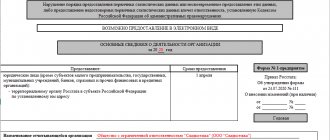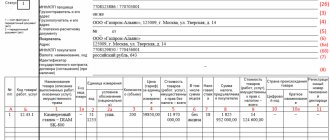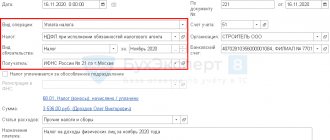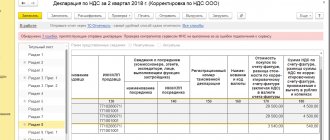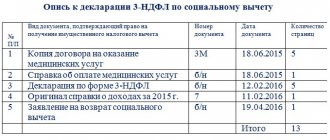Reversal of sales from previous periods
Courses 1C 8.3 and 8.2 » Training 1C Accounting 3.0 (8.3) » Service tools, administration » Adjustment of past periods in 1C 8.3
In 1C 8.3 Accounting 3.0, a simplified mechanism is implemented for adjusting past periods and correcting errors of the past period. Actions when an error is detected vary depending on the impact of the error on tax:
- The tax is underestimated - the previous period is adjusted;
- The tax is not underestimated – adjustment of the current period.
Important! If the accountant plans to make adjustments to the previous period and the tax is not underestimated, then the tax data in 1C 8.3 is adjusted manually.
Let's look at an example.
Let’s say that the Confetprom company discovered a technical error in March when providing communication services for December 2015; the amount of costs was exceeded by 30,600 rubles.
A corrective document, Receipt Adjustment, was issued for this receipt.
It is important to determine the reason for the adjustment (type of operation):
- Correcting your own error - if a technical error is made, but the primary documents are correct.
- Correction of primary documents - if the conformity of goods/services and other things does not coincide with the primary documents, there is a technical error in the supplier’s documents.
Let's look at this example in these two situations.
Own mistake
After correcting the previous period in 1C 8.3, it is necessary to make a Reformation of the balance sheet for the last year in the Operations section - Closing the month in December.
How to correct a mistake if you forgot to enter an invoice, how to take into account “forgotten” unaccounted documents in terms of tax accounting when calculating income tax in 1C 8.3, read our article.
enter the reversing document “Sales of services” with a negative amount of the service - VAT is not reversed from 68.02 invoice. - Tell me, please, how methodically correct in the 4th quarter. reverse this Sale of services to receive in Q4. reversing entries in accounting and VAT registers, as well as an adjusting entry in Additional. Sales Book sheet?
LLC "Company 2" sends LLC "Company 1" a claim that one of the supplied cameras was defective and returns it. On the same day, the seller transfers money for the returned products. In the accounting records, the seller makes the following entries: April 25, 2014 g.Debit 62 Credit 90-74,340 rub.
— revenue for sold products is reflected; Debit 90 Credit 68-11,340 rub. — VAT is charged based on the invoice; Debit 90 Credit 43-51,000 rub. — cost of products sold was written off; May 6, 2014 Debit 62 Credit 90- -24,780 rub. — previously reflected revenue was reversed; Debit 90 Credit 43- -17,000 rub.
Attention
When the buyer returns goods or provides a retro discount, the seller reverses the proceeds. In the event of a detected defect, the buyer draws up a report on the established discrepancy in quantity and quality upon acceptance of inventory items, which is the legal basis for filing a claim with the seller. And based on the claim made by the buyer, the seller’s records appear in red ink.
Example 3. On April 25, 2014, LLC “Company 1” shipped LLC “Company 2” freezers in the amount of 3 pieces at a price of 24,780 rubles. per piece (including VAT - 3,780 rubles). The cost of one camera is 17,000 rubles. May 6, 2014
At the end of the period, the seller provides a discount on already shipped inventory items (for example, for large volumes of purchases). According to accounting rules, revenue is recognized based on all discounts and markups provided to customers (clauses 6 and 6.5 of PBU 9/99 “Revenues”) organizations", approved by Order of the Ministry of Finance of Russia dated 05/06/1999 N 32n). Example 2.
The seller shipped the first batch of goods to the buyer in the amount of 11,800 rubles, including VAT - 1,800 rubles. Then, within a month, the second batch for 23,600 rubles, including VAT - 3,600 rubles. At the end of the month, the seller provided a discount on the shipped goods in the amount of 10%: 11,800 rub. RUB 23,600 = 35,400 rub.; 35,400 rub.
Every accountant has probably encountered such a problem that they need to delete an erroneous document in the previous period. But the period has already closed, the reporting has been submitted. For such cases, 1C 8.3 (as well as 1C 8.2) provides for a reversal operation. It lies in the fact that in the current period all the same movements of the previous document are repeated in all accounting registers (accounting, tax, etc.), but with the opposite sign.
I will demonstrate how to reverse a document in 1C using an example. How to make a reversal in 1C using a document In the 1C 8.3 program: “Enterprise Accounting 3.0” (and in some others that have an accounting module) there is a document “Operations entered manually.” Let's create it. Where is the reversal in 1C? Go to the “Operations” menu, then in the “Accounting” section click on the link “Operations entered manually”. A window with a list of documents will open.
VAT on sales proceeds; July 25, 2014 Debit 62 Credit 90-23,600 rub. — revenue from sales is reflected; Debit 90 Credit 68-3600 rub. — VAT is charged on sales proceeds. On August 4, the buyer was given a 10% discount on shipped goods (RUB 3,540): Debit 62 Credit 90- -RUB 3,540. — previously recorded revenue was reversed by the amount of the discount;
Debit 90 Credit 68- -540 rub. — VAT on proceeds is reduced after issuing an adjustment invoice. The buyer, when receiving a retrospective discount, cannot adjust the cost of capitalized goods (clause 12 of PBU 5/01 “Accounting for inventories, approved by Order of the Ministry of Finance of Russia dated 06/09/2001 N 44n) .
Therefore, he will reflect the discount as other income, even if it was received in the same year as the goods were registered: July 15, 2014 Debit 41 Credit 60-10,000 rubles. — purchased goods are reflected; Debit 19 Credit 60-1800 rub. In a special resource for tax accounting purposes, it is necessary to reflect the permanent difference: Amount PR Dt 60.01 Amount PR Kt 91.01;
- in special resources for tax accounting purposes, add the entry Amount NU Dt 60.01 Amount NU Kt 76.K and reflect the repayment of debt on settlements with counterparties for the transaction that was subject to adjustment (20,000 rubles).
Rice. 3. Reflection of income from previous years in accounting and cancellation of the receipt document regarding VAT. We leave the automatically filled in VAT tab presented without changes. In terms of VAT, the cancellation of an erroneous registration entry for an invoice from the purchase book for the third quarter is carried out similarly to the procedure described in Example 1.
Tax Code of the Russian Federation). If VAT deductible on an inflated amount of expenses was also declared in a larger amount, then an updated VAT return will also have to be submitted. Note. “Red reversal” does not always mean correcting errors. Reference. Methods for correcting data in accounting documents Correction of accounting errors is regulated by Federal Law dated 06.12.
2011 N 402-FZ “On Accounting” (hereinafter referred to as Law N 402-FZ) and the Accounting Regulations “Correcting Errors in Accounting and Reporting” (PBU 22/2010). In order to correct errors, accountants, in addition to using the “red reversal” method, there are several more methods: - proofreading method.
It is used to correct errors in primary documents and accounting registers. How to make a reversal in 1C 8.3 To achieve this goal in 1C Accounting 3.0 (8.3) there is a document Operation: Operations – Operations entered manually: The purpose of the document is represented by a list of the following operations:
- Entering correspondence of accounts for accounting and tax accounting;
- Entering a document using a standard operation;
- Carrying out register adjustments;
- Reversing movements of another document.
To achieve the necessary goals, we are interested in the last possible point. When we click on the Create button, you can see the types of the Operation document.
In general, adjustments to the tax base for income tax as a result of changes in the price or quantity of previously shipped goods are made in the reporting period in which such shipment was originally reflected (Letters of the Ministry of Finance dated July 12, 2017 No. 03-03-06/1/44103, dated February 14, 2017 No. 03-07-09/8251).
But if the cost of goods has decreased, then it will be possible to reflect the decrease in revenue and direct expenses in the form of the cost of previously shipped goods in the period when sales are adjusted. But only if during the period of initial shipment income tax was calculated for payment. Therefore, if, for example, the cost of shipped goods decreased for the March shipment, but according to the results of the 1st quarter, income tax was calculated for payment, then the sales adjustment reflected in May can be shown in the profit declaration for the 1st half of the year.
Attention
Go to the “Products” tab and “Fill in according to the payment document.” Since we must cancel the purchase book entry, after automatically filling out the document, we change all amounts on this tab to negative, and in the “Event” column we select “VAT submitted for deduction.” We post the document and look at the postings. Now we will generate an updated declaration for the 3rd quarter of 2021 (the period when the error was made).
Adjustment of income tax for the previous period
Debit of account 62 “Settlements with buyers and customers” - Credit of account 90 “Sales” - the cost of shipped goods, works or services has been increased (including VAT)
Debit of account 90 – Credit of account 68 “Calculations for taxes and duties”, sub-account “VAT” - additional VAT on sales is charged
Debit account 90 – Credit accounts 41 “Goods”, 43 “Finished products”, etc. – the cost of previously shipped goods has been increased (when adjusting the quantity of goods)
When the price or quantity of shipped goods, works or services decreases, postings are made with a “-” sign, i.e. REVERSE.
Debit account 41 – Credit account 62 – the cost of returned goods is capitalized (excluding VAT)
Debit of account 19 “VAT on purchased values” - Credit of account 62 - accepted for accounting for VAT related to the cost of returned goods
Debit of account 68, sub-account “VAT” - Credit of account 19 - VAT on returned goods is accepted for deduction
Re: How to properly reverse Sales of services from a previous period? AlexX 8 — 03.24.2009 — 21:16 We missed another document “Registration of payment from buyers for VAT” Re: How to correctly reverse the Sale of a service from a previous period? AlexX 9 — 03.24.2009 — 21:18 Option 2: By entering reversing documents You can also enter information into an additional sheet of the sales book by duplicating documents.
To do this, it is necessary to issue two additional documents “Sales of goods and services” on March 1, 2006. In the first document, you must indicate incorrect amounts with a minus sign (in our example, this will be the amount - 2000 rubles, including VAT - 305.08 rubles). And in the second document, reflect the corrected amount (in our example, this is 2,500 rubles, including VAT of 381.36 rubles).
When the buyer returns goods or provides a retro discount, the seller reverses the proceeds. In the event of a detected defect, the buyer draws up a report on the established discrepancy in quantity and quality upon acceptance of inventory items, which is the legal basis for filing a claim with the seller. And based on the claim made by the buyer, the seller’s records appear in red ink.
Example 3. On April 25, 2014, LLC “Company 1” shipped LLC “Company 2” freezers in the amount of 3 pieces at a price of 24,780 rubles. per piece (including VAT - 3,780 rubles). The cost of one camera is 17,000 rubles. May 6, 2014
Eligibility of using the black reversal method
A number of accountants, instead of making adjustments by canceling entries while simultaneously recording the correct indicators, use reverse entries using the black reversal method. Recording a reverse entry that does not have a documentary justification is an incorrect accounting operation.
The fundamentals of accounting legislation do not contain the concept of “black reversal”. The concept of reversal in domestic accounting applies only to transactions with a minus sign. The method is typical for Western schools of accounting.
There is no specific prohibition in the legislation on the use of black reversals, with the exception of credit institutions in which solvency is based on reporting indicators. When using reverse entry in accounting, debit and credit turnover unreasonably increases, distorting accounting data. Additional turnover appears in the reporting. Black reversal is used to exclude transaction amounts.
How to reverse a service provider from a previous period of accounting and tax accounting
— other income is reflected in the amount of expenses incorrectly taken into account last year (the error is assessed by the company as insignificant); August 15, 2014 Debit 60 Credit 84—3000 rubles. — retained earnings increased (the error is assessed by the company as significant).
Let us remind you that this procedure does not apply in tax accounting. An identified error from last year is corrected in the tax period in which it was made, regardless of the time it was discovered. If expenses were inflated, then an income tax arrears arose. Therefore, it is necessary to submit an updated declaration for this tax (Clause 1 of Article 81 of the Tax Code of the Russian Federation). If VAT deductible on an inflated amount of expenses was also declared in a larger amount, then an amended VAT return will also have to be filed.
Note. “Red reversal” does not always mean correcting errors.
Reference. Methods for correcting data in accounting documents Correction of accounting errors is regulated by Federal Law dated December 6, 2011 N 402-FZ “On Accounting” (hereinafter referred to as Law N 402-FZ) and the Accounting Regulations “Correcting Errors in Accounting and Reporting” (PBU 22 /2010).
In order to correct errors, accountants, in addition to the “red reversal” method, have several more methods: - proofreading method. Used to correct errors in primary documents and accounting registers. The incorrect word or amount is crossed out with a thin line so that the original version can be read, and the correct value is carefully written on top.
The correction is certified by the signature of the person responsible for maintaining the register, the date and seal of the organization is affixed (Part 7, Article 9 and Part 8, Article 10 of Law N 402-FZ, Section 4 of the Regulations on Documents and Document Flow in Accounting, approved by the Ministry of Finance USSR 07/29/1983 N 105, and Letter of the Ministry of Finance of Russia dated 03/31.
2009 N 03-07-14/38). Thus, corrections to the accounting registers are made before the totals are calculated. This method is used for “manual” accounting, without the use of computer programs; - a method of additional posting. It is used when the transaction was not reflected in a timely manner or, with correct correspondence of accounts, the transaction amount turned out to be less than the real one.
In this case, an additional accounting entry is made for the amount of the transaction or for the difference between the correct and reflected amounts. At the same time, an accounting certificate is drawn up, which explains the reasons for the correction. Thus, errors identified both in the current and in previous periods are corrected.
Providing retrospective discounts entails reversal of revenue for the seller, the buyer does not change the cost of goods
Accountants have to reverse previously carried out transactions not only in case of mistakes, but also when providing discounts based on the results of shipments for the past period. That is, after the seller ships the goods and records the revenue, and the buyer accepts these goods for accounting. At the end of the period, the seller provides a discount on already shipped inventory items (for example, for large volumes of purchases).
Example 2. The seller shipped the first batch of goods to the buyer in the amount of 11,800 rubles, including VAT - 1,800 rubles. Then, within a month, the second batch for 23,600 rubles, including VAT - 3,600 rubles. At the end of the month, the seller provided a discount on shipped goods in the amount of 10%: 11,800 rubles. RUB 23,600 = 35,400 rub.; 35,400 rub.
x 10% = 3540 rubles, including VAT - 540 rubles. The seller makes the following accounting entries: July 15, 2014 Debit 62 Credit 90 - 11,800 rubles. — revenue from sales is reflected; Debit 90 Credit 68— 1800 rub. — VAT was charged on sales proceeds; July 25, 2014 Debit 62 Credit 90—RUB 23,600. — revenue from sales is reflected;
Debit 90 Credit 68—3600 rub. — VAT is charged on sales proceeds. On August 4, the buyer was given a 10% discount on shipped goods (RUB 3,540): Debit 62 Credit 90— -RUB 3,540. — previously reflected revenue was reversed by the amount of the discount; Debit 90 Credit 68— -540 rub. — VAT on revenue has been reduced after issuing an adjustment invoice.
July 15, 2014 Debit 41 Credit 60—10,000 rub. — purchased goods are reflected; Debit 19 Credit 60—1800 rub. — VAT is reflected on the cost of goods; Debit 68 Credit 19— 1800 rub. - set for VAT deduction on the cost of goods; July 25, 2014 Debit 41 Credit 60 - 20,000 rubles. — purchased goods are reflected; Debit 19 Credit 60—3600 rub.
— VAT is reflected on the cost of goods; Debit 68 Credit 19—3600 rub. — VAT is deductible from the cost of goods. On August 4, the buyer was given a 10% discount on shipped goods (3,540 rubles): Debit 60 Credit 91—3,000 rubles. - other income is reflected in the amount of the discount received from the seller. After receiving a document from the seller about granting a discount or receiving an adjustment invoice, the buyer needs to restore VAT from the cost of goods, accepted for deduction: Debit 19 Credit 60 - 540 rubles. — VAT is reflected on the discount amount.
At the same time, the seller reflects the provision of discounts on goods shipped last year in accounting without using reversal entries, but posts them to account 91 “Other income and expenses” (Chart of accounts and Instructions for its use, approved by Order of the Ministry of Finance of Russia dated October 31, 2000 N 94n).
Reversal entries are recorded when goods are returned in the same year as the sale.
Proceeds from the sale of goods are reflected in the seller’s accounting at the moment of transfer of ownership to the buyer (clause 12 of PBU 9/99). The buyer's right of ownership arises from the moment the seller transfers the goods to him - handing over the goods to the buyer or the carrier (Articles 223 and 224 of the Civil Code of the Russian Federation). If the buyer returns part of the goods to the seller, this means that ownership has not been transferred. Therefore, the seller has no reason to take into account the proceeds from the sale of these goods - he makes accounting adjustments.
Note. When the buyer returns goods or provides a retro discount, the seller reverses the proceeds.
In the event of a detected defect, the buyer draws up a report on the established discrepancy in quantity and quality upon acceptance of inventory items, which is the legal basis for filing a claim with the seller. And based on the claim made by the buyer, the seller’s records appear in red ink.
Example 3. On April 25, 2014, LLC “Company 1” shipped LLC “Company 2” freezers in the amount of 3 pieces at a price of 24,780 rubles. per piece (including VAT - 3,780 rubles). The cost of one camera is 17,000 rubles. May 6, 2014 Company 2 LLC sends Company 1 LLC a claim that one of the supplied cameras turned out to be defective, and returns her.
On the same day, the seller transfers funds for the returned products. In the accounting records, the seller makes the following entries: April 25, 2014 Debit 62 Credit 90 - 74,340 rubles. — revenue for sold products is reflected; Debit 90 Credit 68—RUB 11,340. — VAT is calculated based on the invoice;
Debit 90 Credit 43—51,000 rub. — the cost of products sold was written off; May 6, 2014 Debit 62 Credit 90— -24,780 rub. — previously reflected revenue was reversed; Debit 90 Credit 43— -17,000 rub. — the previously written-off cost of sold defective products was adjusted; Debit 90 Credit 99206— -4000 rub.
— previously reflected profit from the sale of defective products was adjusted; Debit 90 Credit 68— -3780 rub. — deduction of VAT on returned products is declared; Debit 43, 28 Credit 43—RUB 17,000. — acceptance of products returned by the buyer to the warehouse on the basis of an act; Debit 62 Credit 51—RUB 24,780. — money was returned for defective products.
Note. When the “red reversal” method is still used, organizations prescribe in their accounting policies how they keep track of finished products - at the actual cost in account 43 “Finished products” or according to the standard cost, when, along with account 43, account 40 “Output of finished products” is used.
Account 40 is used in small industries and with a small range of products. At the end of each month, the organization compares the balance of account 40 by debit and credit. The deviation shows the difference between the actual cost and the planned cost. The excess of the standard cost over the actual cost (savings) is reversed to the credit of account 40 and the debit of account 90 “Sales”.
Overexpenditure - the excess of the actual cost over the standard cost - is written off from the credit of account 40 to the debit of account 90 “Sales” with an additional entry. In addition, “red reversal” entries are constantly found in the accounting of retail trade organizations that keep records at sales prices. Such organizations form the selling price of goods based on the price at which they purchased goods from suppliers and the trade margin.
The demonstration was carried out using the example of the 1C: Enterprise Accounting 3.0 configuration (in other 1C: Enterprise 8.3 configurations the algorithm is the same). Let's say there is a sales document that has the following postings: We need to reverse the document. Before I show you the right way, I'll show you the wrong way (because...
The need for reversal methods
When reversing, amounts are deducted from the debit and credit entries and changes are made to the registers and documentation. Red reversal is used in the following cases:
- The need to make adjustments to accounting due to a technical error or inattention of the accountant. The method is used for correct postings in cases of incorrect indication of the amount;
- Bringing the value expression of uninvoiced supplies to the actual value;
- Withdrawal of the amount of trade margin on goods sold or written off according to the act;
- The need to reduce valuation reserves;
- Adjustments for excess costs of actual costs over planned costs;
- Providing retrospective discounts based on the results of previous shipments of goods.
Reversal data affecting business accounting indicators must be communicated to partners in order to avoid discrepancies in indicators.
How to make a reversal in 1s 8.3 accounting
for the amount of 2000 rubles. were entered into the 1C: Accounting 8.0 program using the document “Sales of goods and services”, and VAT on sales is reflected in the sales book for March using the document “Formation of a sales book”. In June 2006.
, after making adjustments to the issued invoice, the user can reflect the correction of the error in an additional sheet of the purchase ledger in one of three ways.
Option 1: Using the document “Adjusting entries in accumulation registers” Option 2: Using the introduction of reversing documents Option 3: Using manually filling out the document “Creating sales book entries”...
Info
Sometimes it is necessary to cancel postings for some operation at a time when it would be incorrect to simply delete a document from the database - for example, it was entered in the previous period, which is already closed. What to do in this case? To do this, it is necessary to reverse all movements made by the document, i.e. enter the same movements into the database with a “minus” sign, or, as accountants say, “red”. Let's consider the procedure for reversing documents in the 1C Enterprise Accounting 8.2 program using the example of edition 3.0.
Important
There is no separate document for reversal in 1C Accounting 8. To reverse movements of a document, use the document “Operation (accounting and tax accounting)”. You can add a new operation in the Operations Journal, which stores all types of documents.
Differences in the application of red and black reversal methods
Changes to accounting entries can be made with a plus or minus sign. The black reversal method is a plus operation. The red reversal provides for re-recording the erroneous posting with a minus sign while simultaneously indicating the correct data. Negative entries are made in red ink or in parentheses. When maintaining automated accounting, the entry is highlighted in red.
| Conditions | Red reversal | Black reversal |
| Operation sign | Minus | Plus |
| Purpose | Changing totals with an adjusted entry | Deleting an invalid entry |
| Procedure | Drawing up a reversing entry for the exact amount of incorrect data (repetition with a minus sign) while simultaneously recording the correct entry | Drawing up additional return wiring with a plus sign |
Enterprises that use the red reversal method in everyday turnover, for example, when the planned cost deviates from the actual cost, must secure the right to carry out operations in their accounting policies.
Reversal of documents and registers in 1s 8.3 (8.2) accounting
1p. 6 PBU 22/2010;2p. 3 PBU 22/2010;3p. 14 PBU 22/2010;4p. 9 PBU 22/2010; 5sub. 2 clause 9 PBU 22/2010; 6 pp. 6—8 PBU 22/2010
(1) You determine and establish the criterion for the materiality of an error yourself. It must be fixed in the accounting policy. 3 PBU 22/2010; clause 4 PBU 1/2008
A universal way to correct errors is to submit an updated declaration for the period in which the error was made (hereinafter referred to as the “erroneous” period). Therefore, we would like to immediately draw attention to the features of drawing up and submitting an updated declaration to the inspectorate:
- it must be drawn up according to the form in force at the time the error was made. 5 tbsp. 81 Tax Code of the Russian Federation;
- the adjustment number must be indicated on the title page of the declaration;
- the updated declaration must include not only the corrected data, but all indicators, including those that were initially correct;
- To the updated declaration, inspectors often recommend attaching a cover letter describing the current situation and copies of bills confirming payment of arrears and penalties (if such payment was required, for example, to avoid fines in paragraph 4 of article 81 of the Tax Code of the Russian Federation).
However, the specific procedure for correcting an error depends on the type of tax and what the error led to: an understatement of the tax amount or an overstatement.
If, as a result of an error, the tax amount was underestimated, then adjustments must be made according to the following scheme. Moreover, it does not matter which tax you underestimated.
1 pp. 2, 3 tbsp. 81 Tax Code of the Russian Federation
(1) There is no deadline for submitting an updated declaration. However, there will be no fine for understatement of tax only if an error is discovered and corrected before the inspectorate itself finds such an error or schedules an on-site tax audit for this period. 1 clause 4 art. 81 Tax Code of the Russian Federation
If you submit an amendment, but do not pay the arrears and penalties beforehand, you may be fined for late payment of tax. 1 clause 4 art. 81, art. 122 of the Tax Code of the Russian Federation. True, submitting a clarification in this case may be a mitigating circumstance, citing which you can reduce the fine. 3 p. 1 art. 112 Tax Code of the Russian Federation; Resolutions of the Federal Antimonopoly Service of the Moscow Region dated July 16, 2012 No. A40-90732/11-91-391, dated May 22, 2012 No. A40-41701/11-91-182; FAS NWO dated May 22, 2012 No. A05-8232/2011.
Errors that led to overpayment of taxes do not need to be corrected at all, because this will not make the budget worse. But correcting such errors is beneficial to the organization itself - why waste money in vain?
If you make any corrections to the tax calculation, you must, in the event of a documentary audit, be able to prove that the tax base of the previous period was calculated incorrectly. This means that you should have more than just documents confirming specific income or expenses. You need to have all other primary documents that were taken into account when calculating the tax for the year in which the error was made.
The specifics of correcting errors depend on the type of inflated tax.
Income tax and VAT can be corrected in two ways: either by submitting an amendment, or by correcting them with the current period. But let’s make a reservation right away: when correcting errors made when calculating VAT, the diagram below is applicable only to those that are related to the calculation of the tax base. That is, taxable income was inflated, the tax rate was applied incorrectly (18% instead of 10%), and so on.
1Resolution of the Presidium of the Supreme Arbitration Court of June 28, 2011 No. 17750/10; Letter of the Federal Tax Service dated 02/21/2012 No. SA-4-7/2807; 2 Letters of the Ministry of Finance dated 04/27/2010 No. 03-02-07/1-193, dated 04/23/2010 No. 03-02-07/1-188; 3p. 1 tbsp. 78 Tax Code of the Russian Federation
(1) The risk is associated with the fact that inspectors believe that the correction of errors that led to overpayment of tax is limited by the period allotted by the Tax Code for offset and refund of taxes. 1 tbsp. 78 Tax Code of the Russian Federation; Letter of the Ministry of Finance dated October 5, 2010 No. 03-03-06/1/627. If you are willing to take a risk, it is only justified if the mistake resulted in an overpayment of tax. After all, only in this case will you comply with all the conditions for correcting errors provided for by the Tax Code of the Russian Federation. 54 Tax Code of the Russian Federation
(2) Please note that an updated declaration, according to which the amount of tax is reduced, is a reason for ordering an on-site inspection for the updated period (including a repeat one) p. 10 tbsp. 89 Tax Code of the Russian Federation
— register the initial invoice, reflecting the total data with a minus;
— register the corrected invoice in the usual manner;
However, please note that this scheme is applicable to correcting errors in VAT only if you rely on the Tax Code. After all, in the Rules for maintaining a book of sales. Resolution No. 1137 does not say a word about correcting errors in the current period. Moreover, these Rules provide for the registration of corrected invoices in an additional sheet of the sales book for the quarter of excess VAT accrual.
